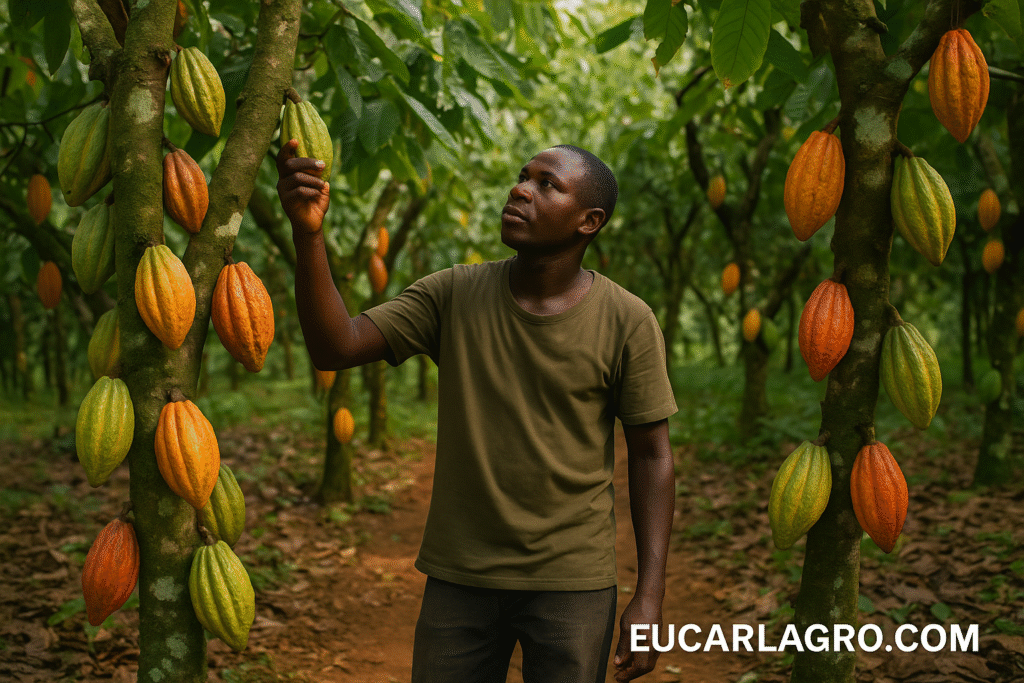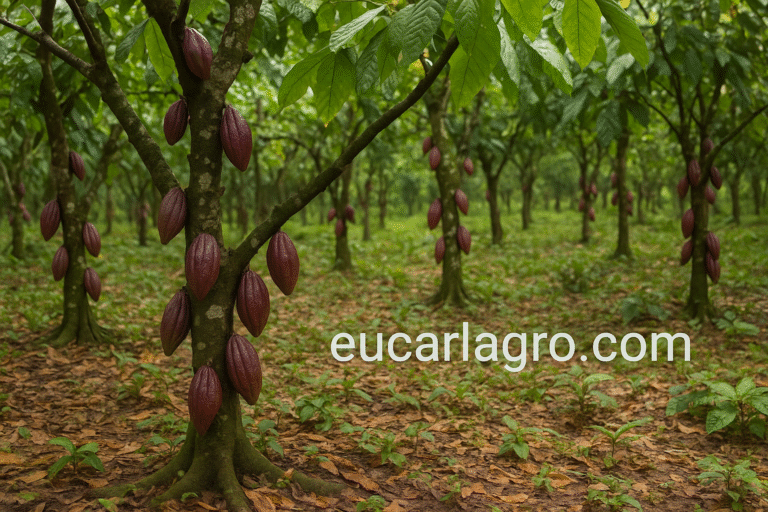How to Start Cocoa Farming in Nigeria: A Step‑by‑Step Guide
Cocoa is one of Nigeria’s most valuable cash crops. It has long played a central role in the economy of states like Ondo, Osun, Ogun, Ekiti, Cross River, and Oyo. With global cocoa prices surging in recent years, more Nigerians—young professionals, retirees, and rural entrepreneurs alike—are taking a fresh look at cocoa farming.
Whether you’re starting with half a hectare or launching a larger commercial venture, this step-by-step guide covers everything you need: planning, land preparation, seedling selection, farm setup, and how to make your cocoa farm productive and profitable.
This guide breaks the process into clear, actionable steps—from feasibility planning to harvest, processing, and selling—so you can start your cocoa farm with confidence.

1. Feasibility Study & Planning
1.1 Market Research
Before breaking ground, understand the cocoa value chain in your region:
- Identify local buyers, cooperatives, licensed buying agents, and processors.
- Study pricing trends over the past 5–10 years.
- Explore export potential and what’s required to meet export standards.
- Investigate the possibility of producing value-added products like cocoa powder or butter.
1.2 Financial Planning
Estimate your startup costs per hectare:
- Land clearing: ₦50,000–₦100,000
- Certified seedlings: ₦150,000–₦200,000
- Labour: ₦50,000–₦70,000
- Fertilizers and agrochemicals: ₦30,000–₦50,000
- Weeding, pruning, and maintenance: ₦40,000–₦60,000 yearly
Keep in mind, cocoa takes 3–5 years to start producing commercially. During this time, you’ll incur maintenance costs without much revenue.
Explore funding options like:
- Bank of Agriculture loans
- Cooperative financing
- Government intervention funds
- Private investors or partnerships
1.3 Legal and Land Acquisition
- Secure a title deed, lease, or legally binding land agreement.
- Ensure the land is accessible by road and has nearby water sources.
- Avoid land in protected forests or areas prone to conflict.
2. Site Selection & Soil Assessment
2.1 Climate Requirements
Cocoa thrives in areas with:
- Annual rainfall between 1,000–2,000 mm
- Temperatures between 21–32°C
- Humidity levels of 70–100%
- A stable, tropical climate with minimal dry-season extremes
Ideal states include Ondo, Ogun, Osun, Cross River, Edo, Delta, Ekiti, Oyo, and Akwa Ibom.
2.2 Soil Conditions
The best soils for cocoa are:
- Deep (at least 1.5 meters)
- Well-drained sandy-loam or loamy soils
- Rich in organic matter
- pH between 5.0 and 7.5
Avoid waterlogged, shallow, stony, or acidic soils. Flat or gently sloped land is preferred for ease of farm layout and drainage.
2.3 Soil Testing
Before planting:
- Test the soil’s pH, organic matter, nitrogen, phosphorus, and potassium levels.
- Apply lime if the soil is too acidic.
- Incorporate compost or manure to enrich poor soils.
3. Choosing the Right Cocoa Variety
3.1 Cocoa Types
Cocoa comes in three main varieties:
- Forastero: Most common in Nigeria, hardy and high-yielding.
- Criollo: Rare and known for flavor, but low-yielding and disease-prone.
- Trinitario: Hybrid of the above, offering good yield and flavor.
For best results, use improved hybrid seedlings developed by the Cocoa Research Institute of Nigeria (CRIN), such as TC1–TC8. These varieties mature faster, resist disease, and yield more pods per tree.
3.2 Sourcing Seedlings
Get certified seedlings from:
- CRIN centers
- State cocoa associations
- Registered private nurseries
Avoid sourcing from unreliable or uncertified vendors.
4. Land Preparation & Planting Layout
4.1 Clearing and Shading
- Clear grass and shrubs, but preserve some tall trees to provide shade.
- Avoid total clearing; cocoa seedlings require 30–50% shade in early years.
- Temporary shade crops (plantain, banana, or maize) can also be planted.
4.2 Marking and Spacing
Use standard spacing of:
- 3m x 3m = about 1,111 trees per hectare
- 3m x 2.5m = about 1,300 trees per hectare
Mark planting spots using pegs in rows for proper alignment.
4.3 Planting Holes and Soil Enrichment
- Dig holes 30cm x 30cm wide and deep.
- Mix topsoil with compost or aged manure (about 5kg per hole).
- Avoid applying raw fertilizer directly into the hole.
5. Transplanting Seedlings
5.1 When to Plant
- Best time to transplant cocoa is early in the rainy season (April–May).
- Ensure seedlings are 5–6 months old and hardened off before transplanting.
5.2 Planting Technique
- Remove the polybag carefully to avoid root damage.
- Place the seedling upright in the hole and cover with soil.
- Press gently and water immediately.
5.3 Mulching
- Apply dry grass, leaves, or husks around each plant base.
- Helps retain soil moisture and suppress weeds.
6. Cocoa Farm Maintenance
6.1 Weeding and Mulching
- Weed manually or with hoes every 6–8 weeks, especially in the first two years.
- Maintain mulch throughout the year, particularly during dry seasons.
6.2 Fertilization
Apply fertilizers starting from the second year:
- Organic: 5–10 kg of manure per plant annually.
- Inorganic: NPK 15:15:15 or 20:10:10 at 150g per plant in split doses.
Apply fertilizers at the beginning and end of rainy seasons (April–May and August–September).
6.3 Pruning
Prune twice a year:
- After harvest and before the rainy season.
- Remove dead, diseased, or crossed branches.
- Maintain an open canopy for air and sunlight.
6.4 Pest and Disease Control
Common cocoa pests and diseases:
- Capsid bugs (mirids) – cause cankers on stems
- Black pod disease – fungal infection that turns pods black
- Cocoa swollen shoot virus – causes leaf yellowing and stunted growth
Control Measures:
- Practice field sanitation.
- Remove infected pods immediately.
- Apply approved fungicides and insecticides.
- Use resistant varieties and plant spacing to reduce spread.
7. Harvesting & Post-Harvest Handling
7.1 Maturity Timeline
- Hybrid cocoa trees start bearing fruit after 18–24 months.
- Commercial yields begin from the 3rd–4th year.
- Peak yields of 1–1.5 tonnes per hectare occur from Year 5–6 onward.
7.2 Harvesting Pods
- Cocoa pods mature about 5–6 months after flowering.
- Ripe pods turn yellow or red, depending on the variety.
- Harvest using a sharp knife or sickle; avoid damaging branches.
7.3 Pod Breaking
- Break pods within 3 days of harvesting.
- Extract wet beans and discard husks or use them for compost.
7.4 Fermentation
- Ferment beans for 5–7 days using banana leaves or wooden boxes.
- Turn beans every 2 days to ensure uniform fermentation.
- Proper fermentation enhances flavor and reduces bitterness.
7.5 Drying
- Sun-dry fermented beans for 7–10 days.
- Spread in thin layers on mats or drying racks.
- Turn regularly to ensure even drying and prevent mould.
7.6 Storage
- Store dried beans in clean, dry, and well-aerated sacks.
- Keep away from moisture, pests, and strong odors.
8. Marketing & Sales
8.1 Local Sales
You can sell your cocoa beans to:
- Licensed buying agents (LBAs)
- Local cooperatives
- Aggregators and exporters
- Chocolate manufacturers
Prices vary depending on quality, moisture content, and market demand.
8.2 Export Opportunities
- Exporting requires registration with regulatory agencies.
- Beans must meet international standards for fermentation, moisture, and cleanliness.
- Work with experienced exporters or consider partnerships.
8.3 Value Addition
Consider processing cocoa into:
- Cocoa powder
- Cocoa butter
- Handmade chocolate
These products can command higher prices locally and abroad.
8.4 Certification
Global buyers increasingly demand:
- Rainforest Alliance certification
- Organic or fair trade labels
- Traceability and sustainability compliance
Certified farms often earn premium prices and secure long-term contracts.
9. Common Challenges & How to Overcome Them
9.1 Delayed Profitability
Solution:
- Intercrop with short-term crops like plantain or maize.
- Have alternate income sources in early years.
9.2 Pests and Disease Outbreaks
Solution:
- Use disease-resistant varieties.
- Practice good sanitation and regular spraying.
- Seek advice from extension officers.
9.3 Pod Theft
Solution:
- Fence the farm if possible.
- Harvest regularly.
- Employ trusted farmhands or community patrols.
9.4 Climate Change
Solution:
- Mulch heavily to conserve soil moisture.
- Plant drought-resistant trees.
- Use irrigation during long dry spells.
9.5 Poor Road Access
Solution:
- Choose farmland near a motorable road.
- Join cooperatives to lobby for infrastructure improvements.
10. Scaling Your Cocoa Business
10.1 Expansion Strategy
- Gradually increase farm size by 1–2 hectares every 2–3 years.
- Train staff or hire experienced farmhands as you scale up.
10.2 Replanting
- Replace unproductive or diseased trees every 20–30 years.
- Consider grafting improved varieties onto old rootstock.
10.3 Cooperatives and Partnerships
- Join cocoa farmer associations for:
- Collective bargaining
- Bulk input purchases
- Training opportunities
- Access to government programs
10.4 Continuous Learning
- Attend seminars, workshops, and field days.
- Stay updated on best practices and new research.
Conclusion: Your Cocoa Farming Action Plan
Starting a cocoa farm is a long-term investment—but one with rich rewards if done right. With proper planning, good agronomic practices, and market awareness, your farm can become a profitable and sustainable venture.
Quick Checklist:
- Study the market and calculate startup costs
- Choose the right land and test the soil
- Source improved, certified seedlings
- Prepare land with shade and proper spacing
- Transplant during early rains
- Weed, mulch, prune, and fertilize regularly
- Control pests and diseases with IPM
- Harvest, ferment, and dry beans properly
- Sell through cooperatives or exporters
- Explore value addition and certification
- Join a cooperative and continue learning
If you need help creating a cocoa farm business plan, designing planting calendars, or estimating yield projections, we are here to help.
